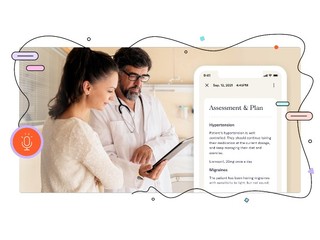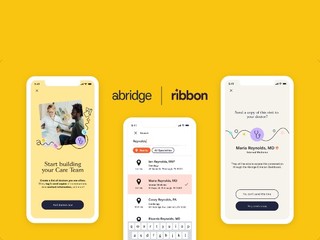The FDA outlines draft guidance on AI for medical devices
The agency also published draft guidance on the use of AI in drug development
Read more... Abridge is a company that helps patients record their doctor appointments, using machine learning to transcribe and highlight the most important parts of the conversation. The idea was helps patient better understand the details of what their doctors had told them by distilling it down and making it easy to understand.
Abridge is a company that helps patients record their doctor appointments, using machine learning to transcribe and highlight the most important parts of the conversation. The idea was helps patient better understand the details of what their doctors had told them by distilling it down and making it easy to understand.
The company also has an enterprise solution takes the same technology that it has used for its patient-centered product, transcribing the call and pulling out highlights, but then goes a step beyond that by automatically creating a draft note of the conversation in the standardized format that doctors use daily.
Now the company will be making a major expansion through a new partnership with The University of Kansas Health System which the company says "will mark the most significant rollout to date of generative AI in healthcare."
Abridge has already helped more than 2,000 clinicians and served more than 200,000 patients; with this new partnership, it has the potential to serve and support more than 1,500 practicing physicians across The University of Kansas Health System’s over 140 locations.
Dr. Gregory Ator, Chief Medical Information Officer and Head and Neck Surgeon at The University of Kansas Health System, spoke to VatorNews about this partnership,
VatorNews: Why is Abridge a good partner for The University of Kansas Health System? What values do you share?
Dr. Gregory Ator: We are both innovators and in fact have set up the KU Center for Health Innovation & Transformative Care to address important problems like documentation inefficiency and effectiveness. Providers need real-time production of accurate and trustworthy notes, which are appropriately summarized to improve the documentation experience and reduce this prime contributor to burnout. Additionally, our patients want to be engaged in their care and the patient portal portion of the product does just that by bringing documentation in an understandable, accurate manner to patients. Abridge is unique in the marketplace in being able to address these issues and is a company we feel like we can partner with long term for our mutual success.
VN: What is Abridge providing for you that you did not have prior to this partnership? What gap do they fill for you?
GA: Current solutions are focused on production of speech to text with providers having to contribute a lot of effort to the final solution. Additionally, products which don’t have as heavy provider input are not real-time affecting one of our prime criteria which is real-time documentation. That is the documentation is available at the time the patient is seen rather than several hours later or even the next day.
Other solutions are expensive with scribes at elbow or variants which are plagued with all of the management issues typical of human based workflows. Every time a management problem is present providers get a decrement to their experience. Such issues as frequent training and onboarding of new personnel is eliminated with the Abridge approach and the quality is as good or better.
VN: How will your patients and clinicians use Abridge? Give me a couple of use cases.
GA: Providers simply place a smartphone adjacent to the clinical conversation and tap the start button. Text is instantly produced which is an appropriately summarized record of the conversation. Providers are not interested, typically, in a word for word transcription, courtroom style, as such unnecessary details impede intelligibility of the finished note. Importantly in regards to the trustworthiness of the solution providers, and patients, can hear what part of the conversation led to that part of the finished product. When an erroneous word is produced the provider can easily refer back to their speech and the context of that speech and determine what changes need to be made. These changes are incorporated into the algorithms as a corrective feedback such that the product learns from its mistakes.
Patients get a similar experience except they will have additional aids to comprehension to help them overcome the difficulty with medical terminology and jargon. The provider gets to use appropriate vocabulary for their needs and patients get language for that medical speak that they can comprehend. This improves the all important communication inherent in good shared medical decision making.
VN: What kind of ROI are you hoping to achieve?
GA: ROI for this type of product is typically hard to calculate. We expect this approach to be less expensive than real time scribes and, as discussed above, this should produce a better experience over the long run by elimination of human scribe challenges and attendant expenses.
Providers spend as much as 120 mins of pajama time, after hours chart work, and over time this takes a toll on family relations and is just not very enjoyable. By restoring some JOY to medicine we anticipate a significant improvement in burnout with corresponding financial benefits to the organization.
VN: What will you consider to be a success in regard to this partnership? What's the end goal?
GA: Our outcomes will be provider and patient satisfaction with the product as to quality of the finished product. Key factors will be accuracy, efficiency, and conciseness. An overall outcome is related to corrections providers must make to be able to sign the finished note. Of course, adoption by providers of the system will be an outcome as well. Not all providers would be best served by this product but our goal would be to have those that should use it actually use and have a great experience. With these fundamentals in place we expect to innovate with other use cases for the product and expend to more roles in organization and importantly use the technology to improve care real-time in the exam room.
VN: Is there anything else that I should know?
GA: Providers are not happy with the current state of talking with a patient and then leaving the room and producing a clerical transcription of that conversation. KU would much rather have our providers engaged directly with patients, rather than worrying about how much detail to capture in their notes and dealing with spelling errors. The last thing a patient wants to see is the top of their provider’s head or frustrated clinicians. We strongly believe Abridge has a product that helps improve communication and care, reduces bothersome clerical activities, and will help get providers home for dinner!
The agency also published draft guidance on the use of AI in drug development
Read more...The biggest focus areas for AI investing are healthcare and biotech
Read more...It will complete and submit forms, and integrate with state benefit systems
Read more...
